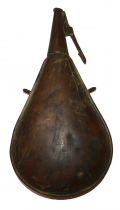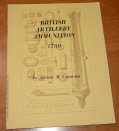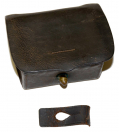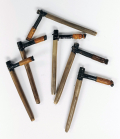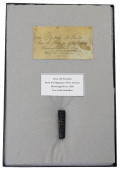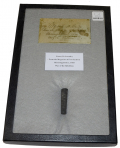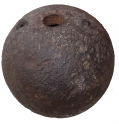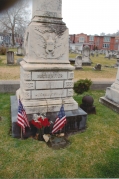site search
online catalog
Artillery
Showing 41 to 55 out of 55
RARE USN GOSPORT NAVY YARD PRIMING FLASK
Gosport Shipyard was the original name of the facility in Portsmouth, Virginia, that was founded in 1767, passed into the hands of Virginia in the Revolution, was leased from that state by the U.S.… (490-6824). Learn More »
NICE U.S. ARTILLERY FUSE POUCH
The leather is in nice, smooth condition with a pleasing dark brown tone. The latch tab is stitched to the underside of the flap. This tab remains unbroken but well worn. The outer flap is only… (490-6254). Learn More »
THEFT REPORTED AT AUTUMN GETTYSBURG SHOW
A vendor at the Autumn Gettysburg Civil War show held at the Allstar Events Complex on Oct. 28-29 reported that a Maryland sword belt plate valued at $3500 was stolen from a display case on Sunday…. Learn More »
BOOKLET ON 18TH CENTURY BRITISH ARTILLERY AMMUNITION FROM THE LIBRARY OF THE LATE DEAN S. THOMAS
The title of this pamphlet is “BRITISH ARTILLERY AMMUNITION 1780” by Adrian B. Caruana and published by Museum Restoration Service of Bloomfield, Ontario, Canada in 1979. Yellow heavy stock paper… (236-416). Learn More »
U.S. NAVY FRICTION PRIMER BOX
Small leather box to hold friction primers were carried on the belt (past terminology designated this type box as a Navy fuse box). The box is relatively square in shape to accommodate the shape of… (490-5342). Learn More »
CONFEDERATE ARTILLERY FUSE POUCH WITH LEAD FINIAL
Brown leather Confederate artillery fuse pouch is in good condition. This is the leather pouch that went on the side of the Confederate artilleryman. It held his paper time fuses for firing the… (381-20). Learn More »
$3,150.00
Originally $3,950.00
CIVIL WAR QUILL PRIMERS FOR NAVAL CANNONS
These Naval cannon primers are constructed using fowl quills; less likely to corrode around salt water. These are percussion, not friction primers. In use, these were ignited by the blow from a… (490-2928). Learn More »
CONFEDERATE TEN SECOND PAPER TIME FUSE
This ten-second fuse originated from the magazine at Fort Jackson, Louisiana. Fuse was recovered by a Union soldier in 1862, who packaged several in a box and documented it by writing the information… (R21944). Learn More »
$200.00
Originally $295.00
CONFEDERATE TEN SECOND PAPER TIME FUSE
This ten-second fuse originated from the magazine at Fort Jackson, Louisiana. Fuse was recovered by a Union soldier in 1862, who packaged several in a box and documented it by writing the information… (R21942). Learn More »
$200.00
Originally $295.00
COPPER SABOT FROM 3” MULLANE SHELL FROM GETTYSBURG
Found in Gettysburg after the battle. From the Soldier’s National Museum auction of 2014. Copper sabot stripped from a Confederate 3” Mullane artillery shell. The sabot is a round disk with a… (224-514). Learn More »
MEXICAN WAR TO CIVIL WAR PORTFIRE STOCK
Before the introduction of the friction primer it was necessary to keep a ready flame handy for the lighting of linstocks carrying slow match to fire the gun or to fire it directly and even later they… (1158-07). Learn More »
RARE 10” MORTAR SHELL (FRENCH & INDIAN OR REVOLUTIONARY WAR) FROM FORT TICONDEROGA MUSEUM COLLECTION
This early mortar shell was once housed in the Fort Ticonderoga Museum collection. It is an excavated 10” mortar shell in relic condition. The iron body of the shell is in solid condition with… (1117-26). Learn More »
COMPLETE PACKAGE OF TAYLOR FUSE IGNITERS
Here is a paper-wrapped stack of tin fuse igniters for Taylor’s time fuse. The whole stack is wrapped in tan packing paper. The packing paper is water damaged, missing a few fragments, and quite… (727-50). Learn More »
THEFT FROM GRAVESITE OF GEN. JOHN REYNOLDS
A large artillery shell, one of pair that sit on either side of the grave of Gen. John F. Reynolds in Lancaster Cemetery, Lancaster, PA has been removed from the site. If anyone comes into contact…. Learn More »
CONFEDERATE 32 LB CANISTER BALL FROM ATLANTA
Offered is a Confederate canister ball from Atlanta Georgia. Each weighs approximately 1 lb. 4 oz. and are 2.10” in diameter. All show signs of moderate to heavy rust. These were uncovered during… (R3556). Learn More »
Showing 41 to 55 out of 55
Most Popular
Historical Firearms Stolen From The National Civil War Museum In Harrisburg, Pa »
Theft From Gravesite Of Gen. John Reynolds »
Selection Of Unframed Prints By Don Troiani »
Fine Condition Brass Infantry Bugle Insignia »
Large English Bowie Knife With Sheath 1870’S – 1880’S »
Imported (Clauberg) Us Model 1860 Light Cavalry Officer's Saber »
featured item
RARE EBERLE 1796 CONTRACT MARKED BAYONET
This rare bayonet is marked by the maker in a sunken cartouche with raised letters on the base of the blade reading “Eberle.” Charles Louis Eberle emigrated to the U.S. from Germany with brothers George A. and Henry J. in 1794, arriving in… (1052-86). Learn More »
site search
Upcoming Events
The shop is currently closed so that we may conduct our annual inventory. We are available by phone… Learn More »



